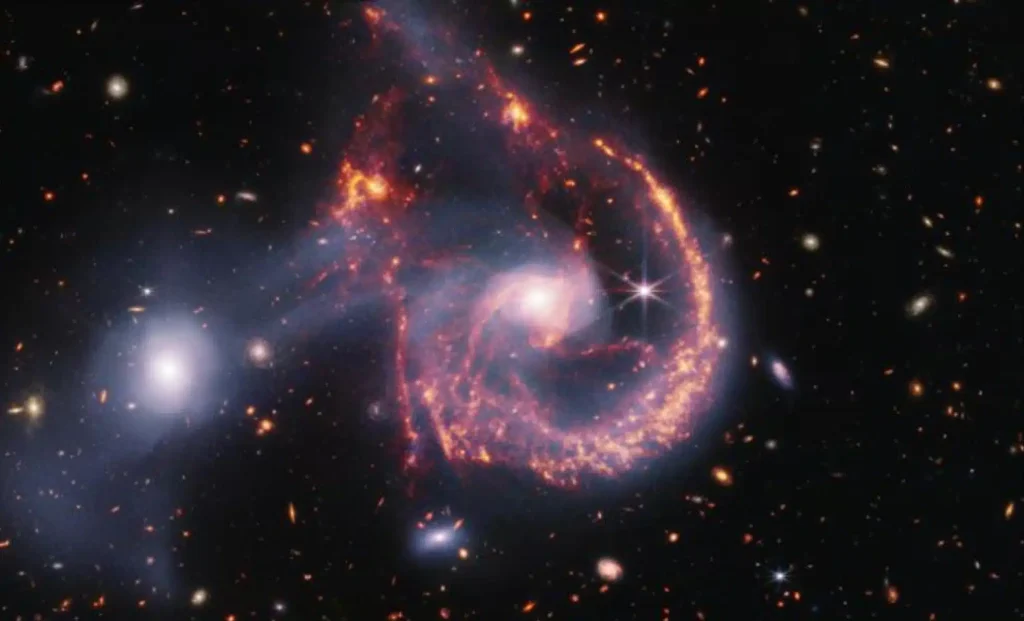The James Webb Space Telescope Offers a Deeper Look Into Galactic Collisions in Arp 107

The James Webb Space Telescope has captured a detailed image of Arp 107, a pair of galaxies in the midst of a collision 465 million light-years from Earth. This event, which began hundreds of millions of years ago, has triggered new waves of star formation and created a bridge of gas and dust between the galaxies. Webb’s infrared capabilities provide unprecedented clarity into this dynamic process.
How Galactic Collisions Trigger Star Formation
When galaxies collide, the interaction can compress large amounts of gas, creating the perfect conditions for the formation of new stars. In Arp 107, the collision between a spiral galaxy and an elliptical galaxy has caused significant gas compression, leading to bursts of star formation. Using Webb’s NIRCam and MIRI instruments, astronomers have identified bright regions of star formation in the spiral galaxy’s arms. These regions are rich in polycyclic aromatic hydrocarbons, organic molecules that glow in the infrared, signaling active star-forming zones.
This detailed observation is crucial for understanding how galactic mergers drive the birth of new stars. James Webb Space Telescope’s infrared data reveal that the interaction between the galaxies is not entirely destructive. While gas compression leads to star formation, some gas is dispersed into space, potentially limiting future star formation in the galaxies. This delicate balance between gas compression and dispersal gives scientists insight into how galaxies evolve over time.
The Role of Black Holes in Galactic Interactions
The spiral galaxy in Arp 107 is classified as a Seyfert galaxy, a type of active galaxy characterized by a bright nucleus powered by a supermassive black hole. In galactic collisions, such black holes can play a significant role in shaping the outcome of the interaction. Webb’s observations offer a detailed look at how the supermassive black hole in Arp 107 influences the ongoing merger, pulling in gas and dust while also affecting the surrounding stars.
The intense gravitational pull of the black hole disrupts the spiral arms of the galaxy, warping their structure as the galaxies interact. This interaction triggers not only the birth of new stars but also influences how material is redistributed within the system. Some of the material falling into the black hole is funneled into jets or winds, which expel energy and gas outwards, further altering the dynamics of the collision. These expelled jets and winds can limit star formation by blowing away the very gas that would normally fuel the formation of new stars.
Webb’s high-resolution infrared images capture these intricate processes, providing insight into how supermassive black holes contribute to both the formation and suppression of stars during galactic mergers. By studying these effects, astronomers gain a deeper understanding of how galaxies and their central black holes co-evolve over time, particularly during periods of intense interaction like mergers. This information is crucial for modeling the long-term evolution of galaxies in the universe and understanding the balance between black hole activity and galaxy formation.\
The Future of the Arp 107 Merger
Although the galactic collision in Arp 107 is still ongoing, it will take hundreds of millions of years for the two galaxies to fully merge. As the galaxies continue to interact, the bridge of gas and stars that currently connects them will likely dissipate, and a new, unified galaxy will emerge. Webb’s observations allow astronomers to watch this process unfold, offering valuable data on how galaxies reshape themselves after such dramatic events.
The James Webb Space Telescope provides an unparalleled opportunity to study these long-term processes. By observing Arp 107 and similar galactic interactions, scientists are able to piece together how galaxies evolve over time, gaining insights into the forces that shape the early universe and the complex dynamics of the cosmic web. With each observation, Webb continues to expand our understanding of the universe’s past and its ongoing transformation.


